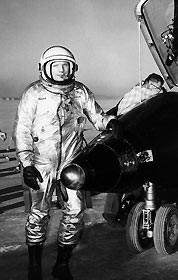
Save this image free of charge
in 800 pixels for layout use
(right click, Save as...)
|
|
Ref : S04523
Theme :
Astronauts - Astronauts training (1725 images)
Title : Pilot Neil Armstrong with X-15 #1
Caption :
NASA test pilot Neil Armstrong is seen here next to the X-15 ship #1 (56-6670) after a research flight. Neil A. Armstrong joined the National Advisory Committee for Aeronautics (NACA) at the Lewis Flight Propulsion Laboratory (later NASA’s Lewis Research Center, Cleveland, Ohio, and today the Glenn Research Center) in 1955. Later that year, he transferred to the NACA’s High-Speed Flight Station (today, NASA’s Dryden Flight Research Center) at Edwards Air Force Base in California as an aeronautical research scientist and then as a pilot, a position he held until becoming an astronaut in 1962. He was one of nine NASA astronauts in the second class to be chosen. As a research pilot Armstrong served as project pilot on the F-100A and F-100C aircraft, F-101, and the F-104A. He also flew the X-1B, X-5, F-105, F-106, B-47, KC-135, and Paresev. He left Dryden with a total of over 2450 flying hours. He was a member of the USAF-NASA Dyna-Soar Pilot Consultant Group before the Dyna-Soar project was cancelled, and studied X-20 Dyna-Soar approaches and abort maneuvers through use of the F-102A and F5D jet aircraft. Armstrong was actively engaged in both piloting and engineering aspects of the X-15 program from its inception. He completed the first flight in the aircraft equipped with a new flow-direction sensor (ball nose) and the initial flight in an X-15 equipped with a self-adaptive flight control system. He worked closely with designers and engineers in development of the adaptive system, and made seven flights in the rocket plane from December 1960 until July 1962. During those fights he reached a peak altitude of 207,500 feet in the X-15-3, and a speed of 3,989 mph (Mach 5.74) in the X-15-1. Armstrong was born August 5, 1930, in Wapakoneta, Ohio. He attended Purdue University, earning his Bachelor of Science degree in aeronautical engineering in 1955. During the Korean War, which interrupted his engineering studies, he flew 78 combat missions in F9F-2 jet fighters. He was awarded the Air Medal and two Gold Stars. He later earned a Master of Science degree in aerospace engineering from the University of Southern California. Armstrong has a total of 8 days and 14 hours in space, including 2 hours and 48 minutes walking on the Moon. In March 1966 he was commander of the Gemini 8 orbital space flight with David Scott as pilot—the first successful docking of two vehicles in orbit. On July 20, 1969, during the Apollo 11 lunar mission, he became the first human to set foot on the Moon. From 1969 to 1971 he was Deputy Associate Administrator for Aeronautics at NASA Headquarters, and resigned from NASA in August 1971 to become Professor of Engineering at the University of Cincinnati, a post he held until 1979. He became Chairman of the Board of Cardwell International, Ltd., in Lebanon, Ohio, in 1980 and served in that capacity until 1982. During the years 1982-1992, Armstrong was chairman of Computing Technologies for Aviation, Inc., in Charlottesville, Virginia. From 1981 to 1999, he served on the board of directors for Eaton Corp. He served as chairman of the board of AIL Systems, Inc. of Deer Park, New York, until 1999 and in 2000 was elected chairman of the board of EDO Corp., a manaufacturer of electronic and mechanical systems for the aerospace, defense and industrial markets, based in New York City. From 1985 to 1986, Armstrong served on the National Commission on Space, a presidential committee to develop goals for a national space program into the 21st century. He was also Vice Chairman of the committee investigating the Space Shuttle Challenger disaster in 1986. During the early 1990s he hosted an aviation documentary series for television entitled First Flights.
|
|

